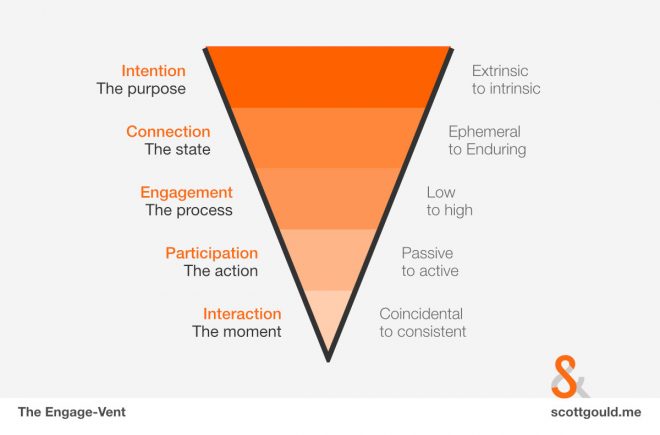The Engage-Vent is like a funnel, the V on your keyboard (think V for Vent!). It’s also a pun that I just couldn’t resist: engage-ment and engage-vent sound rather alike, or at least I think so! Just like a funnel or a vent, this model is a flow of relationship activity. Plus, it allows me to ‘give vent’ to my frustration that a click isn’t engagement, damnit!
The V shape shows how relationship has different building blocks, from the sharp point at the bottom (which is the precise moment of action), to the broad, open ended top (which is the potential of the relationship).
This model breaks down relationship into five units, from the smallest to the largest, providing an auditing tool for the direction and application of any engagement:
- Interaction, the smallest unit, which is the tangible moments of engagement, such as typing on a keyboard or clicking a mouse.
- Participation, which is a series of interactions to create one overarching action, such as creating an asset or buying and installing a product
- Engagement, which is the process in the form of a vehicle or strategy
- Connection, the emotional state or bond between the two entities
- Intention, the top unit, which is the purpose of the relationship.
I argue that engagement is not an end in itself, but is rather the process that serves the intention or purpose for the relationship. Without an understood intention, engagement is not effective.
On the right is what the unit needs to go from and to, i.e. from coincidental interaction to consistent interaction.
___
The first task is to be clear about what engagement is, and what it is not. It is a very popular word, but with varying meanings, thus what engagement is to one is not what it necessarily is to another.
Engagement as a word means to interlock. Its etymology dates from the 14th century and the old French gage, which was a thing that was symbolically through down by a medieval knight to signify that they accept a challenge to fight.
Engagement is often likened to relationship, connection, interaction, and participation, but each one has a different nuance on the scale of generally and specificity:
- Connection is the emotional bond between the subject and the object. The aim of engagement is to build a strong connection that undergirds times of action (participation) and times of non-action (thus being more loyal and having greater longevity).
- Engagement is a the way a connection or bond is built, the interlocking. It is acoming together of two people, and can happen in many ways (which we shall get into). It is very fluid. It is a period of time in which someone is interlocking with someone else, although it can be asynchronous.
- Participation is the currency of engagement. Participation – an exchange – is the mechanism by which engagement happens, whether that is emotional, mental, physical, etc. For instance, a Q&A session or asking someone out on a date is an opportunity for participation, which will hopefully increase engagement.
- Interaction is the precise moment of participation, i.e. when you actually sit down with someone for coffee, like a page, buy something, etc.
Relationship as a term is not included in the above hierarchy, for the reason that relationship is broad phrase to describe the context in which we know people, i.e. a work relationship, family relationship, romantic relationship.
I’ve put this hierarchy into the below model to visualise the hierarchy:
The benefit of defining terms with this level of specificity is that we can now plan engagement more effectively:
To make a bond or long lasting connection, we need to go about engaging the subject.
Engagement is the interlocking. With what shall we interlock with our intended subject? Is this over a shared interest or perhaps a common problem?
To create engagement there must be an opportunity to participate, to give and take. Will this be initially a text or Facebook message, or perhaps an advert that invites people to comment?
Participation requires an interaction that is a specific moment in time. An interaction means creating something that brings two people together: so let’s now put out our piece of content, our survey, our hand to shake someone else’s, etc.
You will no doubt see that we can attach metrics to these, and thus have already begun the work of measuring and monitoring our engagement. This also helps us with strategy and tactics: engagement is the realm of strategy, whereas interaction is the place of tactical implementation,.

Comments